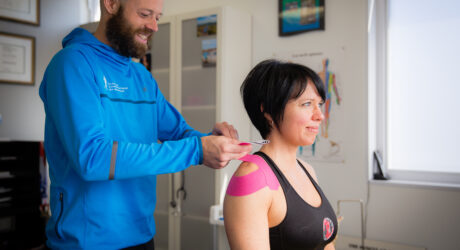Neuro-Proprioceptive Taping
#kinesiotaping

Developed by Dr. Kenzo Kase, chiropractor
The Kinesio taping method is applied to muscles, ligaments, tendons and fasciae to reduce spasms, pain and inflammation. This technique also stimulates the lymphatic system to promote tissue healing. This type of tape won’t reduce joint mobility, allowing maximum range of motion while ensuring stabilization.
- Elastic tape (cotton and acrylic)
- Thickness similar to the skin
- Stretches only along the longitudinal axis (2-way stretching)
- Possibility of stretching to 140-180%
- Hypoallergenic (latex free)
- Duration of 4 to 7 days
- Waterproof
Benefits
- Improves muscle and joint stabilization
- Improves blood and lymphatic circulation
- Corrects muscle function
- Decreases pain
Dynamic Taping
#dynamictaping
Unlike Kinesio Tape (described above), Dynamic Tape (DT) has a multidirectional elasticity. This is an advantage for taping muscles connected to multiple joints and complex three-dimensional movements. The Dynamic Tape is applied to favor the injured muscle or tendon when in action. It’s applied with tension on the muscle or the joint while in a contracted position. When movement occurs, the DT stretches and absorbs the tension.Dynamic Tape therefore helps to reduce muscle load, increase biomechanical efficiency, improve fatigue tolerance and reduce pain. Significant improvement in circulation and lymphatic function is also a positive effect of Dynamic Taping. Thus, Dynamic Taping helps improve endurance and performance!
- Elastic tape (lycra and acrylic)
- 4-way stretch
- Possibility of stretching more than 200%
- Great resistance
- Thickness similar to the skin
- Hypoallergenic (latex free)
- Duration of 4 to 7 days
- Waterproof
Benefits
- Assist’s the work of the injured tissue (muscle or tendon) by reducing its load
- Improves mobility
- Increases stability
- Optimizes the position to improve the muscle’s ability to generate strength

Conventional Taping
The 2 main uses for sports taping:
- Prevention: for high-risk sport activities (for example, the ankles of basketball players, tennis players, trail runners, etc.)
- Rehabilitation re-education: as a protective mechanism during the healing process.
The tape that’s being used to limit movement (mechanical support) must be rigid (non-elastic), adhesive, strong, non-irritating and easy to tear for the therapist.
It must be applied to support the joint, but not limit movements essential to the sport.
